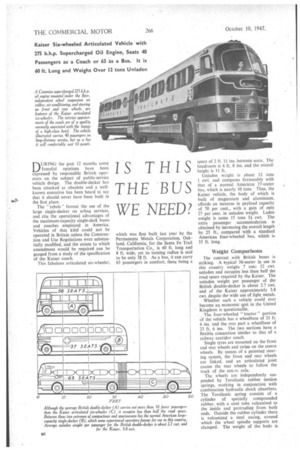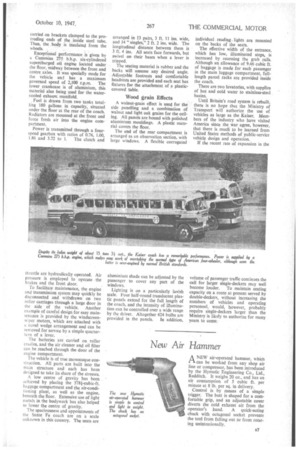IS THIS THE BUS WE NEED?
Page 40

Page 41

If you've noticed an error in this article please click here to report it so we can fix it.
Kaiser Six-wheeled Articulated Vehicle with 275 b.h.p. Supercharged Oil Engine, Seats 40 Passengers as a Coach or 63 as a Bus. It is 60 ft. Long and Weighs Over 12 tons Unladen
DURING the past 12 months some forceful opinions have been expressed by responsible British operators on the subject of public-service vehicle design. The double-decker has been attacked as obsolete and a wellknown executive has been heard to say that it should never have been built in the first place.
The " rebels " favour the use of the large single-decker on urban services, and cite the operational advantages of the maximum-capacity single-deck buses and coaches employed in America. Vehicles of that kind could not be operated in Britain unless the Construction and Use Regulations were substantially modified, and the extent to which amendment would be required can be gauged from a study of the specification of the Kaiser coach.
This fabulous articulated six-wheeler, which was first built last year by the Permanente Metals Corporation. Oakland, California, for the Santa Fe Trail Transportation Co., is 60 ft. long and 8 ft. wide, yet its turning radius is said to be only 3$ ft. As a bus, it can carry 63 passengers in comfort, there being a space of 2 ft. 11 ins, between seats. The headroom is 6 ft. 8 ins, and the overall height is 11 ft.
Unladen weight is about 12 tons 1 cwr. and compares favourably with that of a normal American 37-seater bus, which is nearly 10 tons. Thus, the Kaiser vehicle, the body of which is built of magnesium and aluminium, affords an increase in payload capacity of 70 per cent., with a gain of only 27 per cent. in unladen weight. Laden weight is some 15 tons 3i cwt. The extra passenger accommodation is obtained by increasing the overall length by 25 ft., compared with a standard American four-wheeled bus, which is 35 ft. long.
Weight Comparisons
The contrast with British buses is striking. A typical 56-seater in use in this country weighs 7 ton; 12 cwt. unladen and occupies less than half the road space required by the Kaiser. The unladen weight per passenger of the British double-decker is about 2.7 cwt. and of the Kaiser approximately 3.8 cwt. despite the wide use of light metals.
Whether such a vehicle could ever become an economic qnit in the United Kingdom is questionable.
The four-wheeled " tractor " portion Of the vehicle has a wheelbase of 21 ft. 6 ins, and the rear part a wheelbase of 23 ft. 6 ins. The two sections have a flexible connection similar to that of a railway corridor coach.
Single tyres are mounted on the front and rear wheels and twins on the centre wheels. By means of a patented steering system, the front and rear wheels are linked, and an articulated joint causes the rear wheels to follow the track of the cen:re axle.
The wheels are independently suspended by Torsilastic rubber torsion springs, working in conjunction with combination hydraulic shock absorbers. The Torsflastic spring consists of a cylinder of specially compounded rubber, with a steel tube vulcanized to the inside and protruding from both ends. Outside the rubber cylinder there is vulcanized a steel casing, around which the wheel spindle supports are clamped. The weight of the body is carried on brackets clamped to the protruding ends of the inside steel tube. Thus, the body is insulated from the wheels. .
Exceptional performance is given by a Cummins 275 b.h.p. six-cylindered supercharged oil engine located under the floor, midway between the front and centre axles. It was specially made for the vehicle and has a maximum governed speed of 2,100 r.p.m. The lower crankcase is of aluminium, this material also being used for the watercooled exhaust manifold.
Fuel is drawn from two tanks totalling 180 gallons in capacity, situated under the floor at the rear of the coach. Radiators are mounted at the front and force fresh air into the engine compartment.
Power is transmitted through a fourspeed gearbox with ratios of 0.76, 1.00, 1.86 and 3.72 to 1. The clutch and
arranged in 13 pairs, 3 ft. 11 ins, wide, and 14 singles," .2 ft. 2 ins. wide. The longitudinal distance between them is 3 ft. 4 ins. All seats face forwards, but swivel on their bases when a lever is tripped.
The seating material is rubber and the backs will assume any desired angle. Adjustable footrests and comfortable headrests are provided and each seat has fixtures for the attachment of a plasticcovered table.
Wood grain Effects
A walnut-grain effect is used for the side panelling and a combination of walnut and light oak grains for the ceiling. All panels are bound with polished aluminium mouldings. A plastic material covers the floor.
The end of the rear compartment is arranged as an observation section, with large windows_ A flexible corrugated individual readinglights are mounted on the backs of the seats.
The effective width of the entrance, which has low, illuminated steps, is increased by recessing the grab rails. Although an allowance of 9.46 cubic ft. of baggage is made for each passenger in the main luggage compartment, fulllength parcel racks are provided inside the coach.
There are two lavatories, with supplies of hot and cold water to stainless-steel basins.
Until Britain's road system is rebuilt, there is no hope that the Ministry of Transport will authorize the use of vehicles as large as the Kaiser. Members of the industry who have visited America since the war agree, however, that there is much to be learned from United States methods of public-service vehicle design and operation. If the recent rate of expansion in the




















































































